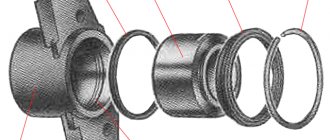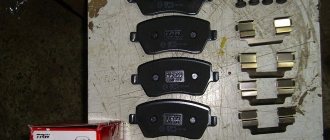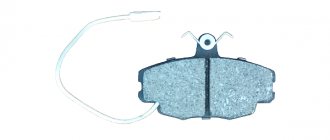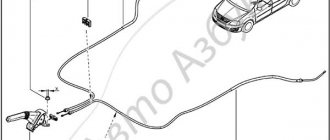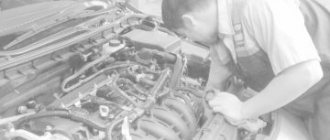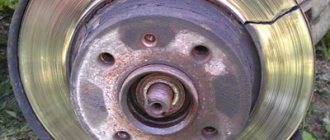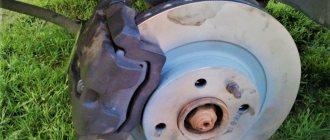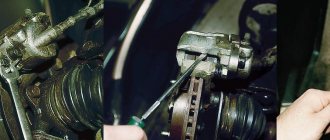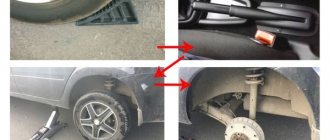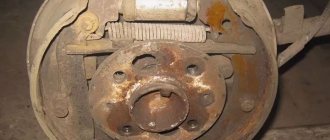How the brakes work
In most modern cars, the braking system is divided into two independent hydraulic circuits.
If one of them fails, the car does not lose the ability to brake, although the efficiency drops significantly. This can cause uneven wear on the pads and brake rotors, as well as squeaking on only one side. The brakes consist of a flat disc made of a special alloy, a pair of brake pads, and a caliper with hydraulic pistons. The disc is placed between two pads with a special friction composition, which are pressed with great force by the caliper when you press the brake pedal. The manufacturer selects materials in such a way as to increase braking efficiency, while disc wear remains within acceptable limits (usually 100,000 - 150,000 km).
Brake pads are a consumable material, the quality of which determines the comfort and efficiency of braking, and therefore safety. It is advisable to use spare parts recommended by the manufacturer.
Reason #3: poor quality pads
Today, almost all spare parts of this type are of more or less high quality, but occasionally it happens that the block is either too hard and does not have an anti-squeak lining, or is very soft and clogs everything with dust.
Some pads do not wear in even after 1000 km. Others wear out after 1000 km. But this happens extremely rarely.
You can flatter yourself with hopes that repeated replacement will solve the problem only if the brake discs are new and there are no doubts about the installation.
Otherwise, most of even Turkish or Chinese brake pads are quite tolerable and should not whistle if you have a working system.
The way out is to buy original spare parts or analogues from good companies, read reviews.
Diagnosis of brake system faults
When the brakes squeak when braking, it is necessary to identify the cause of the malfunction, because in addition to the unpleasant sound, other problems also appear:
- The braking distance lengthens because the working surface wears out and does not grip the disc as expected.
- To brake, you need to apply more force to the pedal.
- In the event of sudden braking, the pedal often feels beating due to uneven wear of the pads or discs.
You can diagnose the state of the system when the brakes squeak on your own, which requires:
- remove the wheel cover;
- carefully inspect the disc and brake pads;
- a gray coating on them indicates that the working surface is being worn out;
- the appearance of metal particles in the plaque indicates the need to replace the pads.
It is advisable to do such an inspection every two to three thousand kilometers, which will allow you to avoid critical situations. If a whistle is clearly audible when braking, the real picture will be visible after removing the wheel, when the disc and pads are completely exposed. This is due to the fact that it is necessary to evaluate the condition of both the external and internal parts of the pads. If the design does not provide a wear sensor, you need to carefully inspect the pads; if the working lining is worn down to 2 mm, it is best to replace the pads without waiting until the metal begins to scratch the brake disc.
When diagnosing, inspect the brake disc. It wears out slower than pads because it is made of wear-resistant hard metal. It should not have cracks, holes, chips, or visible deformations. To determine the condition, just run your finger and feel the chamfer that appears as a result of wear, and if it reaches 2 mm, the disc is considered worn out. There is still enough metal in it, but it becomes too thin and prone to constant overheating, leading to deformation.
How to check brake pad wear
First of all, it is worth analyzing the thickness of the friction linings, comparing it with the permissible value. The thickness measurement procedure is performed in the following order:
- the car is raised on a jack and the corresponding wheel is removed;
- the thickness of the lining is visually determined through the hole in the brake caliper (see image);
- if the thickness of the clutch without a metal base is less than 1.5 mm, the entire part must be replaced.
If you notice that your car's brakes are squeaking when braking, and you notice uneven wear or completely worn out grooves on the brake pad, then the problem lies in the brake caliper. In this case, the caliper will also have to be changed.
A similar check should be carried out on each wheel, even if the brakes do not squeak everywhere. It should be remembered that the braking system ensures the safety of the car, so you need to check the brakes regularly and change worn parts in a timely manner.
Creaking noise when braking after replacing pads
After installing new parts, squeaking may occur. It occurs as a result of the fact that the components of the mechanism have not gotten used to it. During operation, the surface of the disk or drum wears unevenly. After installation, the new pads do not fit tightly.
To eliminate extraneous noise, the components need to be ground in. To do this, you need to drive the vehicle for some time. To reduce grinding time, the braking system is actively used.
Sharp braking does not promote rapid grinding. When the wheels lock, the friction layer is pressed against the disk or drum, completely stopping its rotation. To speed up the grinding process, it is necessary to perform smooth braking.
After the friction layer completely follows the contours of the disk, the system will operate normally. The sound in the area of the wheel mechanisms will disappear.
The brakes squeak after replacing the pads and when the geometry of the indicator is violated. If the plate is bent during installation, it will rub against the disk.
Friction part material
Now let's figure out why squeaking occurs when braking. Let’s take the disk material – steel – as an invariable given, and exclude the whistling from the list of causes. This means the reason is in the clutch material.
Manufacturers of original pads, for a well-known reason, keep the friction material secret; their brakes do not squeak. They found their own composition of friction material, which in all respects is compatible with the metal of the brake disc.
It’s important to say here that making friction material is not easy; you need to maintain a compromise ratio of the hardness of the material.
If you make it softer, there will be no creaking, but there will be rapid wear. If you make the material too hard, the braking efficiency will be high, the amount of wear will be low, but the squeaking guarantee will be ensured.
It has already been established that some friction materials are incompatible with the metal of the brake disc and no matter what you do, the brakes will still squeal. Only replacement can help, and only from a different manufacturer. Better than the original ones.
It also happens that after replacing even with original ones, there is still a squeaking noise when braking. Don't worry, the whistling will go away in a couple of days. The manufacturer makes a special layer that wears off in a day or two and the squeak will disappear.
Features of brake pad designs
Metal plates installed between the base of the pads and the piston of the brake cylinder are sometimes used as a cure for squeaking. Sometimes this saves you from unnecessary vibrations.
Let's look at the design of the block. If there is a creak, then there is a vibration that our ear can hear. It would be logical that if we can change the vibration frequency towards the inaudible range, then we will get rid of the squeaking and whistling of brakes.
Manufacturers use a trick and divide the friction area into parts. They cut grooves and make two or more segments on the clutch. The smaller the segment, the less its mass and the higher the vibration frequency. The main thing is to bring this frequency to a zone close to ultrasound, which is inaudible to the human ear.
As a rule, the depth of these slots is approximately 4 mm, width 2 mm. You can experiment and try to cut it yourself into n number of sectors.
Sometimes the edges of the pads are rounded. In this case, the creaking noise during braking is extinguished due to the gradual increase in pressure of the pads on the disc.
But the noise can also be caused by the brake discs themselves. As a rule, due to their wear, and it usually does not go evenly. A worn disk, if you have seen it, does not have a flat surface, but a wavy one.
If you measure the surface area of a wave-shaped disk, it will be larger than that of a new one, and therefore the vibration frequency will be different.
The disc can be deformed; this happens when a disc heated by braking gets into cold water, for example, into a deep puddle. Here you need to groove the disc or replace it.
A worn-out wheel bearing can also cause squealing brakes, but this is rare.
If a squeak appears, in any case, you should look at the pads and remember when you changed them. Maybe it's just time to replace them.
Many pads have wear indicators (“creaks”). They are plates of soft metal fused into the friction layer. When the pads become critically worn, metal begins to rub against metal, producing an unbearable squealing sound from the brakes. In this case, only replacement will help.
If the squeaks from the brake area are non-standard, be it knocking or periodic grinding without pressing the brake, then you should pay attention to the brake mechanisms. It is possible that your brakes are worn out and require replacement.
Reason three - wear of the strips
In this case, the bars whistle or begin to creak when braking based on two factors of their wear:
- Complete wear of the friction layer, at which friction of the brake disc begins with the metal base of the pad.
- Incorrect mounting of the mechanical pad wear sensor. After installing new strips and a certain mileage, a whistle may be observed when slowing down.
Why do the pads squeak when braking on a car?
The pads squeak due to vibration during friction against the surface of the brake disc. The nature of this phenomenon depends on many factors, including the rigidity of the steering knuckle vibrations. Cars coming off the assembly line are immediately equipped with special anti-squeak plates that prevent the brakes from squeaking.
- Poor quality material
Why can a brake pad squeak when braking a car if its design is in good order? First of all, the reason may lie in the material of the friction lining. This polymer part consists of more than 20 elements. Some manufacturers save on this compositional composition in order to reduce the cost of the product as much as possible. It is important not to be tempted by the low price, because the braking system is responsible for traffic safety. - Different manufacturers
The brake discs and pads used must be made by the same company. For example, when replacing original discs with products from TRW, pads of this brand should also be installed. Products from different manufacturers may be incompatible with each other. - Break-in of brake pads
New pads may squeak at the initial stage of their use in the car. Immediately after installing them, they should run in, and after a while the creaking will stop. The unpleasant sound is produced by the protective layer, and this layer gradually wears away. To speed up this process, you can perform several intense braking sessions on a straight and free section of the track. After this the brakes will stop squeaking. - Dirt or water ingress
The pads squeak when braking is also due to contamination or moisture. A typical example is that the brakes begin to squeak after driving through a puddle. In this case, it is enough to wait until they dry. If dirt gets in, the pads should be cleaned. - Wear of parts
Brake pads are equipped with wear indicators (“squeakers”), which are metal plates. These plates begin to creak or emit a characteristic squeal when the car brakes if the pads have reached a critical level of wear. If the “squeak” creaks, this is a signal to replace the worn part as soon as possible.New brake pads can also creak during braking if the indicator plate is fastened poorly, as a result of which the plate prematurely touches the disc, producing an unpleasant creak.
- Brake heating
Brakes with non-ventilated discs also tend to squeak due to elevated temperatures. If in hot weather driving a car is accompanied by frequent alternations of braking and acceleration, even new pads will begin to creak. A slight squeak occurs when the brake discs become very hot and disappears after the brakes cool down.When changing pads, if possible, lubricate the caliper guides with appropriate lubricant (for example, grease, CV joint grease, and similar). Due to lack of lubrication, the brakes will also squeal when braking.
Although squeaking brakes are unpleasant for people in a car, this symptom does not affect the quality of braking itself. If it turns out that it is not the pads that are squeaking, you should check the remaining parts of the brake system, cleaning them of dirt. The brakes will probably stop squeaking after assembling, disassembling and lubricating the moving parts of the system.
Dirt, clay and the costs of a new product
Let's start with a fairly common cause of squeaking brakes - poor-quality material of the polymer friction lining, which contacts the brake pad with the disc. In addition, pads and discs from different manufacturers may not be completely compatible with each other, and their “union” will become a source of squeaking and grinding. There are recommendations to give preference to products from one manufacturer.
Rambler without advertising
Another conditionally natural cause is the layer that covers new brake pads. It takes time for them to break in, and for the composition on the friction coating to wear out. You can speed up the process with a series of more or less intense and, of course, safe braking. But if extraneous sounds still do not want to disappear, then you should contact the service.
Pads can make a heartbreaking howling sound when liquid dirt and clay enters the brake system and then dries out. If you had to drive off-road or just on a dirty road section with known consequences, then remove the wheel, wash it, clean the caliper and other elements of the brake system. For disc brakes, use a special cleaning compound.
From souring to wear
It happens that the pads squeak due to souring in the caliper. In this case, anti-squeak brake lubricants will help - they cover the caliper guide pins after removing the old grease and degreasing the surface. The pads are also carefully lubricated, according to the instructions, and inserted into the cleaned grooves of the caliper. Then the brake disc is cleaned and degreased with a special compound.
Rambler without advertising
Howling can be caused by heat, especially in the case of cars that have brake discs without ventilation. When they get hot, they report this with a characteristic sound. After cooling, the brakes are silent again. And in this way, the pads notify others about the car owner’s carelessness - the fact is that when the friction lining wears out, the indicating plate may come into contact with the brake disc. By the way, the pads can sometimes whistle and squeak not at all in an attempt to remind you of the need for urgent replacement, but simply due to poor-quality fastening of a special plate that will begin to contact the disc.
The condition of the pads is checked visually - turn the steering wheel all the way to the side and inspect the friction layer. If it is sufficient and has not turned into a thin strip, and the creaking is heard when moving, then contact the service to identify and eliminate the cause.
Creaking noise when braking after replacing pads
If the squeaking noise does not disappear after the steps described above for lapping the pads, this may indicate that the materials of the brake pads and brake disc are incompatible.
In this case, the solution would be to replace the pads with more suitable ones, or change both the pads and the brake discs (it is advisable that all elements be from one trusted manufacturer).
However, taking into account the higher cost of such kits, owners do not always immediately change brake discs. The reason is that visually the disk may not have serious defects. However, it should be taken into account that the surface of the disc may be worn unevenly.
The disk may also be deformed. For example, brake discs “lead” as a result of falling into water after braking. As a rule, during active braking, the disc becomes very hot from friction, then it cools sharply.
Another cause of deformation may be simple overheating of the disk. This happens if the driver actively and constantly brakes, practices prolonged braking, keeps his foot on the brake pedal, etc. Another reason may be a malfunction of the brake system, when the brake caliper jams and does not completely remove the pads from the disc.
In any case, if the geometry of the brake disc is broken or there is constant overheating, the brakes will, at a minimum, squeak. What’s much worse is that there is a risk of reduced braking efficiency; the wheels may brake unevenly, which leads to a pull when braking, etc.
It becomes clear that the brake discs also need to be checked separately, since a simple visual inspection is not enough. Next, based on the test results, the brake discs are either regrooved or completely replaced.
Let us also add that the cause of squeaking brakes may not be the brake system at all. In fact, the wheel bearing can also creak when braking. The fact is that when braking, the load on this element increases, which leads to the appearance of extraneous sounds.
Why do car brakes squeak?
From practical experience, there are three main reasons why brakes may squeak when braking. The main advice that you can get from experienced drivers is to buy new pads. However, this may not always help.
Brake disc with visible wear
Let's figure out how, in general, this grinding and whistling sound appears. According to experts, squeaking when braking is always present, only under normal conditions it is beyond the range of human perception. When the special compound comes into contact with the disc, vibration appears. Depending on the frequency of this vibration, a sound audible or inaudible to the human ear occurs.
Three reasons for squeaking:
- Wear.
- Materials and quality.
- Incorrect installation.
When braking
The most common cause is worn brake pads. Brake disc wear is a little less common. However, replacing with new pads solves the problem in more than half of the cases.
Firstly, due to wear, the original shape of the friction linings is lost (slots, curves, irregular shape, etc.). Secondly, uneven wear appears on the disc, which can lead to a decrease in braking efficiency and the appearance of squeaking. Thirdly, some cars use pads with a special “squeak” (metal insert), which begins to rub against the disc when worn. It signals the need for replacement.
In these cases, it is enough to buy new pads and wait until they get used. If there is a development on the brake disc in the form of longitudinal waves around the circumference, then it can be taken to a lathe for turning. If its thickness is less than that allowed by the manufacturer, it will need to be replaced with a new one.
Special slot for improved cooling and reduced squeaking
In more rare cases, squeaking occurs due to a broken brake caliper or wheel bearing. When developing caliper guides, the geometry of the pressing surface of the pads to the disc may change. The wheel bearing shouldn't cause the brakes to squeal, but it can make a lot of noise. In any case, diagnostics and repairs are necessary.
After replacing new brake discs and pads
Another reason why brakes squeak when braking a car can be a simple incompatibility of the material of the brake disc and the friction linings on the pads. This happens, and the owner has to replace practically new parts. Therefore, we recommend using parts recommended by the manufacturer.
You can select a suitable kit from non-original spare parts. But in this case, there is a risk of “running into” poor quality and inappropriate composition of the linings. This may result in reduced mileage on one set of pads, increased disc wear, or decreased braking performance.
Installation of a new brake disc is carried out only with new pads
Creaking can also occur due to weather conditions. Some friction compounds begin to creak when the temperature drops in winter. It should disappear after several braking and warming up. New pads can also creak, even on showroom cars. Some manufacturers apply a special compound to the surface of the brake pads. This layer is very thin, and it will be erased after several sharp braking or a couple of tens of kilometers around the city.
Due to incorrect installation
People often complain on forums that after visiting a service station, new brakes squeak when braking the car. If you have confidence in the purchased spare parts, then the cause may be incorrect installation, despite the fact that replacing the pads is a fairly simple operation.
One of the most extraordinary mistakes is installing the pads upside down. However, most often at service stations they forget to install the pressure spring. Also, a tin anti-vibration gasket is not always installed between the caliper and the pad base. This simple piece of hardware dampens excess vibration, ensures even distribution of downforce, and can also improve cooling.
What to do if your brakes squeak
Perhaps the least obvious way to get rid of squeaking brake pads is to create cuts on the pad. This method is used both by reputable companies producing similar products and by garage craftsmen who have appreciated the effectiveness of this method. The essence of this method is that any creaking is vibration. Accordingly, dividing the vibrating array is an excellent way to change the vibration frequency. To do this, you need to make several cuts on the working surface of the block. But, if the manufacturer, dividing the block in this way, has an idea of how this will affect its performance and reliability, then you perform such an operation at your own peril and risk.
Sometimes lubrication of the guide calipers with a special product helps eliminate squeaking. And when replacing pads, all elements of the brake system that may need it should be lubricated.
Complete with brake pads, you can often find special anti-squeaking agents. These are plates that are installed between the brake pad and the piston. Such plates are designed to provide a tighter and more uniform fit between the pad and the brake disc. If the pads you bought do not come with such plates, you can purchase them separately.
Rounded edges on brake pads are another way to reduce vibration. This configuration allows the blocking force of the pad to be made more gradual, thereby reducing the level of vibration of the pads.
Replacement
There are situations when the squeak is really very strong, although the brake system element was recently purchased and installed.
A new pad does not guarantee perfect and silent operation. Given the likelihood of manufacturing defects and defects, there is always the possibility of repeated replacement.
It is possible that you chose the wrong pads, or fell for the trick of scammers who, under the guise of original and expensive spare parts, sell low-grade fakes. There's nothing you can do about it. You will have to remove the part again, buy and install new friction linings. It is not worth using a fake, since it is unknown how the car will behave the next time you press the brake pedal.
When choosing new pads, be sure to check their high quality. Price does not play a key role, but you shouldn’t buy frankly cheap spare parts either. The likelihood of their weak and short-term operation is small, even if they do not creak.
Overlays
You can solve the problem of new pads squeaking with the help of anti-squeak brake pad plates. They are sold in auto parts stores separately from the pads themselves, but then they are installed on them.
Installation is carried out strictly according to the manufacturer's instructions. You cannot use any outside guidance or advice from friends. As the manufacturer said, do exactly that.
Complete with linings or plates that protect new pads from squeaking, a special lubricant is required. Its composition is strictly prescribed by the manufacturer, so only it will interact optimally with the anti-creaking plate. Lubricant is applied to the back of the lining.
It is important to note that many factory brake pads for cars are already equipped with anti-squeak plates. But there are also those where these additional elements are missing. Their installation is extremely simple, so even a beginner can cope with the task.
These pads are designed not only to combat possible squeaks from new brake pads. They perform an additional function, which is to remove excess heat. This prevents overheating of the brake discs and increases their service life.
Anti-squeak plate for pads
For the sake of fairness, it must be added that the attitude of motorists towards anti-squeak linings is ambiguous. Whether to use them or not is up to each car owner personally. But if you initially bought low-quality pads that use ineffective friction material, no lining will help correct the situation. Here you need to change the block to a better one.
If you have taken a product of decent quality, want to increase the efficiency of the brake system and increase the service life of the pads, then feel free to buy and install anti-squeak plates.
Lubricants
Special lubricants have a temporary effect as the brakes work under increased loads. Because of this, even the most durable high-temperature lubricants gradually lose their effectiveness.
Lubricants are mainly used in situations where extraneous noise from new pads causes discomfort during the grinding-in period. To reduce the level of extraneous sound activity, you can use lubricants and pastes. They come in several types:
- Pastes with anti-seize effect. They are recommended to be used for processing staples, the back of the pads and plastic, which are aimed at preventing the occurrence of squeaks. They rather complement the main solutions rather than act as an independent means to combat squeaking. But no one can deny the fact that they work effectively when used correctly.
- Lubricants intended for processing calipers. If the problem is in the caliper, then you can try using this type of lubricant. They should be used carefully and only when necessary.
- Universal lubricants. Such products are applied to the moving parts of the entire brake system, made of dense, elastic and even plastic elements.
The calipers, plates, and lubricants are designed to keep new brake pads from squeaking after replacement. If you have chosen the elements correctly, installed them on the car strictly according to the instructions, and also did not violate the operating rules, there will definitely be no problems with squeaking after grinding in.
But if all of the listed anti-squeak measures are used, it happens that the pads still squeak. Here the complaints are more about the manufacturers of the pads, and not about the low efficiency of the solutions used. Make sure you buy quality parts. If not, it is better to replace the pads as soon as possible. Saving yourself all the time with pastes, lubricants or plates is not an option. We need to fight the cause, not just eliminate the symptoms.
What is brake lubricant used for?
The results of applying brake lubricant depend on the area where it is applied. Coating the guides in the wells of the caliper brackets leads to increased smoothness, reduced wear, and a reduced risk of jamming and scuffing.
There are means to help eliminate high-frequency squeaks. They help reduce extraneous noise during braking. Anti-squeak pastes also protect against corrosion.
To facilitate disassembly, anti-stick compounds are used. They have a copper or nickel base and have anti-creaking properties.
Lubricating the seating surfaces makes caliper assembly easier. At the same time, the use of special means to simplify the installation of pistons in cylinders helps reduce the risk of corrosion.
What to lubricate when replacing brake pads
When replacing the front or rear brake pads, you need to apply lubricant to the caliper guides. This will protect them from souring, deformation, corrosion, and also reduce mechanical wear. If the vehicle has an ATE brake system with open guides, the use of special agents is strictly prohibited.
To reduce high-frequency sound, you need to apply a thin layer of paste between the plate and the non-working side of the pad. It is recommended to coat the ends of the consumables with a special agent. This prevents the pad from rubbing against the caliper. It is prohibited to use block lubricant for the guides - the rubber boots will swell. The tightness will be lost, moisture will get inside, and the corrosion process will begin.
When replacing brake pads, lubricant is also applied to the plates holding them. It reduces the volume of extraneous sounds and protects against rust. It is worth applying the paste not only to the staples, but also to the seats.
For reliable operation of disc brakes, it is recommended to lubricate the piston. This will allow it to move freely inside the cylinder. It is important that the composition does not react with the brake fluid. The effect of thermal fluid on lubrication is discussed in more detail in the video:
It is not necessary to remove the piston to apply the product. There is a high risk of cuff rupture, so when servicing the unit, it is important to balance the risk of damage to the boot and the need to change the lubricant on the piston. If you lack the necessary skills, it is better to contact a car service.
Treat fastening joints with special means. Then it will be easier to disassemble the mechanism. To prevent spontaneous unscrewing or damage to the thread, it is necessary to control the tightening torque using a torque wrench.
If replacing the pads involves installing a new disc, the surface underneath should be coated with an anti-stick agent. Copper grease in aerosol cans is suitable. The spray torch must be directed carefully so that the liquid does not fall on rubber or plastic surfaces.
Lubricant requirements
The lubricant must meet the following requirements:
- do not freeze at low ambient temperatures;
- be inert towards water and brake fluid;
- have a high operating temperature (150-180°C);
- do not enter into a chemical reaction with parts of the brake mechanism, do not cause deformation of the anthers;
- the dropping temperature should be absent or be as high as possible;
- exhibit chemical resistance to aggressive substances;
- do not leak or melt throughout the entire service life;
- have anti-corrosion properties;
- do not allow contacting surfaces to stick;
- do not wash for a long time.
Many brake mechanisms use rubber, which is based on a copolymer of ethylene, propylene and diene monomer. Rubber is highly sensitive to lubricant quality.
When choosing a composition, you should focus on the recommendations of the car manufacturer.
Species diversity
The range of lubricants for brake mechanisms is impressive. Moreover, these compounds are designed to treat certain parts of it, which does not make the task of choosing the right lubricant easier.
So, all lubricants for treating brake mechanisms can be divided into three types. The first includes compounds for lubricating brake pistons during assembly of the mechanism, the second - for guide pins, the third - so-called anti-squeak compounds, for non-working surfaces of brake pads and brake mechanism frames.
What to do to make new brakes stop squeaking when braking the car at low speed
Actually, if nothing was done before the grinding noise appeared, then this is a call to at least inspect the area around the calipers. Where to look has already been discussed; these cases do not require additional comments. An interesting list of actions in relation to fresh pads, which after installation began to squeak. Replacement immediately is not an option, this is a last resort method.
Lapping in
Give the friction linings time to grind in. After several hundred kilometers of city travel, their working surface will be in full contact with the disk, and this is a reason to stop the whistling, but not the only one.
In relation to pads, the term “molting” is relevant. The fact is that the product includes organic products of the oil refining industry - resins. Overheating, the latter turn into gas, and a gas gasket appears between the friction part and the disk. The effect is similar to hydroplaning of car wheels.
High-quality products undergo “molting” once or twice and only when heated. “When cold,” they do not creak, unlike low-grade models. By the way, the latter's burn-in knows no limits - they will squeak all the time.
Sports pads have their own specifics. If you do not burn through, the brakes on the car will constantly whistle even when braking at low speed. Baking consists of several series of accelerations and decelerations with breaks. The main goal is to overheat the pads to the point where there is smoke in the area of the wheels:
- Stops smoothly from 60 km/h to 0 km/h. Repeat 5 times.
- Drive 1 km without braking.
- Slow down from 80 km/h to 0 km/h. Do it 5 times.
- Drive 2 km without stopping.
- Perform steps 1-4 again.
- Cool the brakes during 5-10 km of non-stop driving.
Lubricate
Never use a work surface! It is necessary to lubricate those areas that are adjacent to the bracket and the surfaces of the caliper. This will help avoid additional vibrations, because not only the friction layer can squeak.
Do not use just anything, but use copper anti-squeak paste (for example, Mannol Kupfer-Paste or Liqui Moly Kupfer-Paste). It does not dry out at high temperatures and is suitable for the prevention of guide supports.
Before installing new pads, it is appropriate to inspect the contact surfaces of the bracket. If there are burrs and wear on them, smooth them out with a needle file. And don’t forget about the caliper guides - they also need lubrication and periodic replacement. By the way, their wear is recorded as the cause of knocking when turning the steering wheel at low speed.
Reassemble the mechanism
There should be anti-squeak plates on the back of the product. They do not always sit tightly on the base adjacent to the brake caliper. If records are left in the box, you should put them back immediately. If it doesn’t help, then use a paste.
Sources
- https://TechAutoPort.ru/hodovaya-chast/tormoznaya-sistema/skrip-tormozov.html
- https://avtocity365.ru/ustrojstvo-i-ekspluatatsiya-avtomobilya/skrip-i-svist-tormozov/
- https://rad-star.ru/pressroom/articles/skripyat-kolodki-pri-tormozhenii/
- https://auto-ru.ru/skrip-pri-tormozhenii.html
- https://auto.rambler.ru/navigator/42315364-pochemu-skripyat-tormoza/
- https://KrutiMotor.ru/na-mashine-skripyat-tormoza-pri-tormozhenii-prichiny/
- https://AvtoNov.com/%D1%81%D0%BA%D1%80%D0%B8%D0%BF%D1%8F%D1%82-%D1%82%D0%BE%D1%80% D0%BC%D0%BE%D0%B7%D0%B0-%D0%BF%D1%80%D0%B8-%D1%82%D0%BE%D1%80%D0%BC%D0%BE% D0%B6%D0%B5%D0%BD%D0%B8%D0%B8/
- https://DriverTip.ru/repair/chto-delat-skripyat-novye-tormoznye-kolodki.html
- https://ddcar.ru/blog/poleznoe/smazka-pri-zamene-tormoznyh-kolodok
- https://www.zr.ru/content/articles/916928-smazka-dlya-tormozov-kakuyu-vyb/
- https://autobann.su/pochemu-skripyat-kolodki.html
